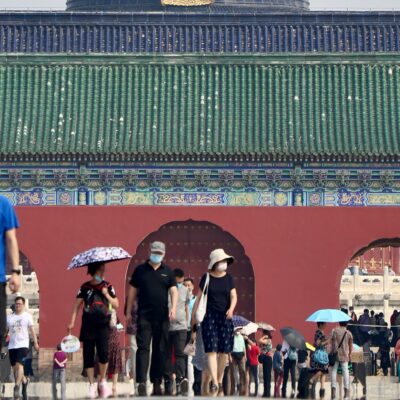China and India are two rising Asian powers with a long history of civilisational, religious and cultural exchanges, but also a modern history of conflict, distrust, and regional rivalry. At the end of their nationalist and liberation struggles and the founding of the new republics in the middle of the 20th century, India and China saw themselves as fellow postcolonial nations confronting the shared challenges of poverty, underdevelopment and the need to carve out a place for themselves in the emerging post-World War II international order. Despite the initial bonhomie and expressions of solidarity with each other, the two Asian giants have been engaged in periodic border standoffs and a growing competition for regional influence.
From postcolonial cousins to bitter rivals
While China was engaged in its historic struggle against colonialism and Japanese aggression in the 1930s and 40s, India’s leading nationalist movement at the time, the Indian National Congress, sent a medical mission to assist China. This act of solidarity with Chinese people, along with vocal support by India for the People’s Republic of China’s membership of international organisations, created a conducive environment for the two postcolonial states to form a friendly relationship in the 1950s. These kindly sentiments were, however, not to last long as bilateral relations plunged into acrimony, culminating in a brief but bloody war in 1962 over disputed borders, itself a legacy of colonialism. Indians felt betrayed and humiliated by an increasingly radical and aggressive China under Mao Zedong. The sentiments of Asian solidarity and shared struggles were soon replaced by distrust and hostility on both sides. China’s military takeover of Tibet in 1950, and its refusal to accept the colonial era border between Tibet and India, had set the scene for the 1962 war. The flight of the Dalai Lama to India in 1959 added an extra layer of complexity to bilateral relations.
While the two nations adopted very different economic and political systems in the late 1940s, their levels of development were not remarkably different until the late 1970s. Because of its democratic political system and free press, India was spared the trauma of famine and political violence experienced during the Great Leap Forward and the Cultural Revolution in China. The post-Mao market-oriented economic reforms in China, however, marked the beginning of a gap in economic and military power (also referred to as comprehensive power by some scholars) between the two countries that has continued to widen over the past 40 years. Despite India’s own economic transformation over that period, China’s economy today is five times the size of India’s and its military spending is at least four times that of its southern neighbour.
Growing power asymmetry
Along with rapid industrialisation, China has made great strides in military modernisation and is now capable of producing most of its military hardware domestically, while India still relies heavily on imports and technological collaboration with foreign arms manufacturers. The growing economic and military power asymmetry between the two countries has emboldened China to exert greater influence in India’s immediate neighbourhood by ramping up economic assistance to South Asian states under its controversial Belt and Road Initiative (BRI). It has significantly boosted various types of funding to Pakistan, Bangladesh, Nepal and the Indian Ocean island states of Sri Lanka and Maldives over the past decade.
India’s western neighbour Pakistan, a long-time ally of China (there is no formal mutual defence treaty between China and Pakistan, but the latter regards China as its most trusted friend and partner) has been the largest beneficiary of the BRI, with China committing more than US$50 billion to the China-Pakistan Economic Corridor (CPEC)—a flagship scheme unveiled in 2013 under the BRI. China is building road, railway, port and power infrastructure projects in Pakistan as part of the CPEC. It is now Pakistan’s largest trading partner and foreign investor.
India, on the other hand, has been one of the harshest critics of the BRI. India’s objections to BRI have centred primarily on the CPEC, which passes through the Gilgit-Baltistan area of Kashmir, where China is widening and upgrading the Karakoram Highway it built in the 1970s that provides road connectivity between the two countries. Since both India and Pakistan claim all of Kashmir, the area is regarded as Indian territory by India. In its criticism of the BRI in 2017, India’s Ministry of External Affairs said in a statement: ‘Connectivity projects must be pursued in a manner that respects sovereignty and territorial integrity,’ with the clear implication that the CPEC was a violation of India’s sovereignty.
Aside from its objections to the CPEC, India has also made several other criticisms of the BRI that range from breaches of international norms to creating an unsustainable debt burden on the recipient countries that would leave them vulnerable to Chinese pressure. In 2016, India’s then Foreign Secretary, S. Jaishankar, described the BRI ‘as an exercise in hard-wiring that influences choices’ of smaller, less powerful states. Jaishankar was reflecting India’s view—shared by many other states—that the BRI is an attempt by China to unsettle the established rules-based international order and replace it with a China-centric system that would marginalise other major players such as India. From India’s point of view, therefore, China’s attempts to increase its geo-economic influence in South Asia and the Indian Ocean are seen as a geopolitical threat.
So as not to be seen as opposing connectivity initiatives and belittling the infrastructure needs of its neighbours, India is also financing a number of infrastructure projects in South Asia, Southeast Asia and Iran. India’s Northeast has seen a new focus on connectivity with neighbouring Bangladesh and Myanmar as part of a project to link India with Southeast Asia by road. Until the Taliban takeover of power in Afghanistan in August 2021, India had undertaken a series of major projects there in sectors ranging from education and health to transport and energy, giving the landlocked nation over US$3 billion in aid. India has also proposed infrastructure initiatives in partnership with other friendly powers such as Japan and the United States. In a speech at the Shangri-la Dialogue in Singapore in 2018, Prime Minister Narendra Modi had China’s BRI in his sights when he said: ‘We understand the benefits of connectivity. There are many connectivity initiatives in the region. If these have to succeed, we must not only build infrastructure; we must also build bridges of trust.’
Trust between India and China, however, is in short supply as China has also developed close security ties with India’s neighbours, including as their major arms supplier. It has replaced the United States as Pakistan’s biggest weapons supplier, with almost half of all Chinese arms exports to Asia during 2010-2020 going to Pakistan, according to a report by the Washington-based Centre for Strategic and International Studies (CSIS). Bangladesh and Sri Lanka also buy significant quantities of arms from China, with Bangladesh accounting for almost 20 percent of all Chinese arms exports to Asia. In 2018, China confirmed that it was selling sophisticated optical tracking systems to Pakistan that could help the South Asian nation to develop multi-warhead nuclear missiles. Another good example of close military cooperation between China and Pakistan is the joint development of JF-17 multi-role combat aircraft used by the Pakistan Air Force. Pakistan has also ordered four Type 054AP frigates from a Shanghai shipyard, the first of which, PNS Tughril, was commissioned into the Pakistan Navy in November 2021, becoming its most capable warship to date.
As I wrote in 2018, China’s growing naval forays into the Indian Ocean have also prompted the Indian Navy to augment its own capabilities in the region. China’s naval presence in the Indian Ocean region has increased not only because its dependence on oil imports from the Middle East and Africa has grown, but also because it sees itself as an important stakeholder in the region. It also wants to counter Indian influence among Indian Ocean island states such as Maldives, Mauritius and Seychelles. China began its naval deployments in the Indian Ocean as part of its contribution towards international anti-piracy efforts authorised by the United Nations Security Council. Working closely with the European Union and other UN member states in the Gulf of Aden, China sent more than two dozen naval groups to the region between 2008 and 2017 as part of the international anti-piracy operations.
In 2017, China established a permanent presence in the region by building its first overseas military base in Djibouti. Identified initially as a logistics facility to support the People’s Liberation Army Navy’s anti-piracy operations, the Djibouti base is a fully-fledged military facility with the presence of all branches of the Chinese military. It has a large helicopter facility and accommodation for 10,000 military personnel, although less than 2,000 personnel are believed to be deployed at the base. According to senior American military officials, a new 1,200-foot pier built by China in Djibouti is capable of supporting China’s new aircraft carriers and other large warships.
Competing visions of regional order
Even a cursory review of Chinese and Indian security literatures will confirm that the two Asian powers have very different visions of the region. While Indian leaders and influential strategic thinkers endorse the rules-based international order—a phrase popularised by the United States and its allies—China’s grand strategy is driven by the ultimate objective of preventing the rise of any peer competitor in Asia, provided it can achieve the withdrawal of the United States forces from the region (particularly in Japan and South Korea—a big if!). In other words, although China rhetorically calls for multipolarity and declares that it will never seek hegemony, its endgame appears to be the realisation of a unipolar Asia dominated by the People’s Republic.
China’s strategic support for and arms sales to South Asian states, especially its close security relations with Pakistan, are seen in New Delhi as part of its strategy to prevent the rise of India as an Asian power in its own right. From Beijing’s perspective, the Quad that brings together Australia, Japan and India with the United States and their Indo-Pacific concept portend an unwelcome scenario in which an economically and militarily resurgent India could forge an alliance with the United States and Japan to counter Chinese influence in Asia. China’s vociferous objections to the Quad and the Indo-Pacific initiative suggest that such an alliance, if it were to materialise, would significantly undermine Beijing’s strategic objectives.
In fact, it is China’s continuing and growing military and diplomatic support for Pakistan and its aggression on the Line of Actual Control (the un-demarcated Sino-Indian border)—most recently in 2020 in Ladakh—that have strengthened support for closer security ties with the United States and its other allies, such as Japan and Australia, among the Indian public. Despite the growing power asymmetry, India is not fearful of China and is proactively working with other countries to balance Chinese power in the Indo-Pacific region, as well as defending its 7,500-kilometre coastline and 2.4-million square kilometres of Exclusive Economic Zone. While India is mindful of China’s sensibilities and does not want to unnecessarily provoke conflict on its long border with China, it is not willing to allow China a veto over its relations with other countries.
Having declared itself a nuclear weapons power in 1998, India has developed a nuclear triad capability as a part of its ‘minimum credible deterrence’ nuclear doctrine. This means that Indian armed forces are capable of launching retaliatory nuclear strikes from land, air and sea. Apart from developing its arsenal of nuclear-capable ballistic missiles, India has also begun to strengthen its border infrastructure at an unprecedented speed to match China’s already superior infrastructure in these areas. It has pushed back against Chinese attempts to build infrastructure or fortifications in border areas that it regards as its side of the LAC. Indeed, the accelerated pace of construction of border infrastructure by both sides may have contributed to the more frequent occurrence of clashes along the LAC between the two sides in recent years, including Doklam in 2017 and Galwan in 2020.
These and other changes in India’s foreign and security policies are part of a trend that has been happening over much of the past two decades. For example, the shift from non-alignment to multi-alignment is part of a long-term reorientation of Indian foreign policy, which has been given an added impetus by China’s aggressive moves along the border. However, as Professor Rory Medcalf reminds us, ‘India will not easily shake off its long allergy to alliance entanglements,’ but it is now much more open-minded about security cooperation with other powers than it has ever been. It has signed three so-called ‘foundational agreements’ for enhanced security cooperation with the United States. The first of these, the Logistics Exchange Memorandum of Agreement (LEMOA), was signed in 2016, which was followed up by the signing of the Communications Compatibility and Security Agreement (COMCASA) in 2018. The last of the three, the Basic Exchange and Cooperation Agreement (BECA), for geo-spatial cooperation, was signed in October 2020. Taken together, these agreements facilitate the mutual provision of logistical support, export of sensitive defence equipment and exchange of intelligence.
In addition to the United States, India has also signed logistics support agreements with Australia, Japan, Singapore, South Korea and France. But India’s quest for strategic autonomy means that India is also pursuing a similar agreement with Russia, with which it has maintained a close defence relationship for many decades. Despite Russia’s growing strategic closeness to China, India continues to buy a large proportion of its defence equipment from Russia. The two countries enjoy a Special and Privileged Strategic Partnership that saw India defy the threat of American sanctions to purchase the S-400 missile defence system from Russia.
India is also a member of the China- and Russia-led Shanghai Cooperation Organisation (SCO), the Brazil-Russia-India-China-South Africa (BRICS) grouping as well as the Russia-India-China trilateral. India’s participation in the Indo-Pacific initiative and the Quad has not stopped it from participating in other fora with Russia and China. So far it has been able to work both sides of the street.
Conclusion
India has adopted a complex strategy of dealing with the threat posed by China’s growing strength and the increasing power asymmetry between the two countries. This includes strengthening diplomatic, economic and security ties with most of its South Asian neighbours. It also involves forging closer security ties with the United States and other Western powers, while maintaining its traditional defence ties with Russia. At the same time, India continues to participate in security groupings like the SCO where both China and Pakistan are members. Whether India can sustain this complex policy setting will depend on a range of factors that include the future direction of US-China relations, China’s domestic politics and India’s own economic development trajectory.
Dr Pradeep Taneja is an Academic Fellow of the Australia India Institute and a Senior Lecturer in Asian Politics in the School of Social and Political Sciences at the University of Melbourne.
Image: Prime Minister of India Narendra Modi and President of China Xi Jinping, September 2017. Credit: Kremlin/WikiCommons




